How To Clear Cache On Macbook Pro Retina
Cached files are temporary files that your computer downloads and stores to save time in the future. For example, when you visit a website, your browser downloads the images and saves them in a cache folder. The next time you visit the site, your browser quickly loads the data from the cache rather than downloading it again. Cached data includes files, images, videos, scripts, and other multimedia.What are cached files?
It's not only your browser that stores cached files. Other apps such as photo and video editing software also create cached data. Even Apple's own apps, such as Spotlight and Maps, and macOS itself store cached files. There are three main types of caches: browser cache, system cache, and application cache (also called user cache).
What does clearing cached data do?
Clearing your cache deletes unnecessary data and frees up disk space. But is it a good idea to get rid of all those cached files?
While cached files help images and other on-page elements load a bit faster when you revisit familiar sites, you don't usually need the stored data in the cache. Consider for a moment every website you've ever visited online — every eshop, every social media profile, every search. That's a lot of images and videos stored on your computer, and you probably won't give most of those sites a second glance.
And that's just your browser cache — there's also your system and application caches. If you've never cleaned out your caches, you may have gigabytes of unnecessary files taking up space on your machine.
That's why regularly clearing the cache is a great way to help clean up your Mac. And remember, a clean Mac is a faster Mac.
Clearing out the cache will also:
-
Remove personal data that's stored by sites or apps.
-
Refresh online content so you aren't loading anything outdated from the cache.
-
Help troubleshoot issues with apps and/or make them run more smoothly.
Can I delete all my cache files on a Mac?
No. You can't delete your entire cache, because your computer accesses some cache files at all times. You can remove all cache files that aren't actively in use, but that doesn't necessarily mean you should. It's a good idea to delete all the browser cache files on your Mac. If you use multiple browsers, you can delete all the browser caches on your machine.
When it comes to the system and user (application) caches, you can delete the inactive cached files but shouldn't do so indiscriminately. Recall that caches help things load faster the next time you need them. So if there's an app you use frequently, such as a photo editor, you don't necessarily want to purge its cache — especially if you're in the middle of a project. Your system cache also generally stores what it needs to run and doesn't need to be completely cleared most of the time.
You'll generally need to clear the system or application caches only when you're troubleshooting a problem or running critically low on space.
Is it safe to delete cache files on a Mac?
While it's safe and easy to delete cache files from all browsers on a Mac, you need to be a bit more careful when digging into the system and user caches. See below for precise instructions on deleting the system cache and user cache.
If you're looking to more securely protect your personal information, you should also consider deleting your browsing history and clearing your cookies.
Want an easier solution? A dedicated cleaning app such as Avast Cleanup for Mac will deep-scan your machine and root out the unnecessary files hanging around on your system. It'll easily identify the files you can delete right away, while making sure you save everything that's needed for your computer to run properly — as well as your favorite photos, songs, and other important files.
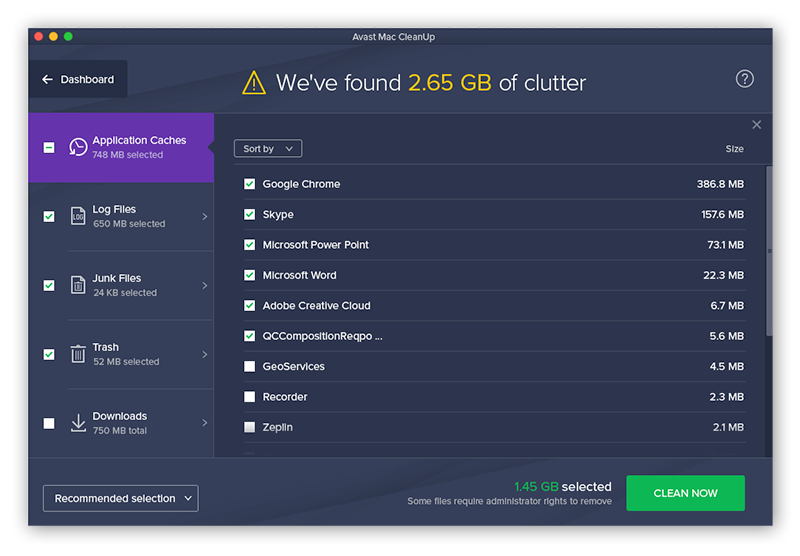
Quickly and safely find all the cache files, log files, junk data, files stuck in Trash and Downloads, and more. Streamline your Mac and enjoy tons of newfound extra space.
How to clear your browser caches
No matter which browser you use, the process to clear the cache isn't too difficult. The main problem is that after clearing it, the cache will start to build up again as soon as you resume browsing. You can use a dedicated browser cleaner to keep your cache clean and for other automatic maintenance tasks. But now let's discuss how to manually clear your cache on any browser.
-
How to clear cache in Safari
-
How to clear cache in Google Chrome
-
How to clear cache in Firefox
-
How to clear cache in Avast Secure Browser
How to empty the cache in Safari
Let's start by emptying the cache in Safari.
-
Open Safari.
-
Under the Safari drop-down menu, click Preferences.

-
Select the Advanced icon at the top, and check the box at the bottom for "Show Develop menu in menu bar."

-
Select the Develop menu and then click Empty caches.

And that's it! An even quicker way is to use keyboard shortcuts, so you don't even have to go hunting for the Safari cache location. Just hit Command + Option + E and your cache will clear automatically.
How to empty the cache in Google Chrome
Are you a Google Chrome user? Here's how to clear the cache on Mac for Chrome:
-
Open Chrome, click on the three dots in the upper-right corner, and select Settings.
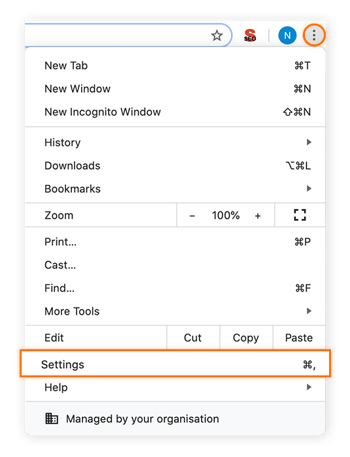
-
Select Privacy and security on the left side, and then select Clear browsing data.

-
Under Time range, choose how far back you want your data to be wiped. We recommend All time.

-
Make sure you check the box for Cached images and files, and then hit Clear data.
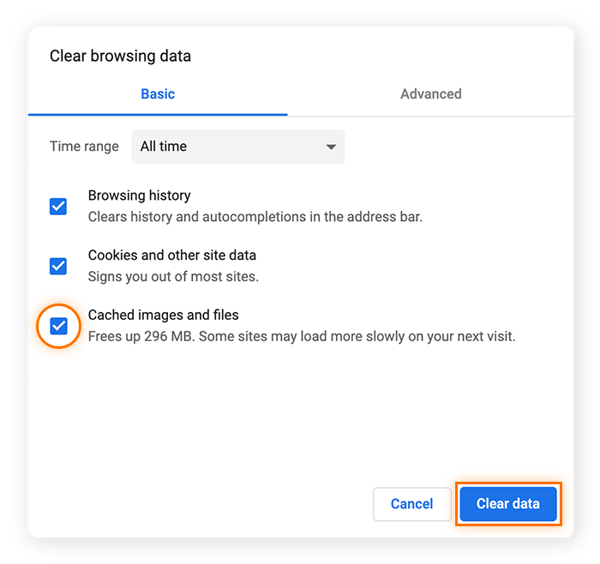
If you prefer a keyboard shortcut, simply hit Command + Shift + Delete to clear the cache.
You can avoid building up cached files by using Incognito mode in Chrome — but that means you'll have to specifically open a private window every time you navigate anywhere, so it's not the most elegant solution.
How to empty the cache in Firefox
Erasing your cache in Firefox is easy.
-
Select History from the top menu bar, and click Clear Recent History…

-
Under Time range to clear, select Everything.
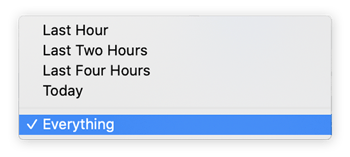
-
Make sure you check the box for Cache, and then hit OK.

And just like that, you're done! You can also use the keyboard shortcut Command + Shift + Delete to bring up the Clear All History menu.
How to empty the cache in Avast Secure Browser
Did you know that your browser gets bogged down with other data that is a lot worse than the contents of your cache? While temporary files can build up and slow down your web surfing, your browser also collects loads of private information about you.
Advertisers are able to follow you around the web using methods like web tracking to gather insights into your habits and interests and target you more precisely. Even more insidious, techniques such as device fingerprinting can be used to create profiles of you based on your device, browser, and IP address. That makes it easier to identify you out of the vast crowd of internet users.
If you'd like to experience the open internet without being tracked or targeted, consider using Avast Secure Browser, specifically designed by security experts with privacy at the forefront. You can take advantage of a full suite of privacy and security features, all for free.
.png?width=664&name=Avast-Browser%20(1).png)
Prevent invasive tracking, scrub your online footprints, block ads, and more. Download Avast Secure Browser for free, install it, and give it a spin today.
Once you have Avast Secure Browser, it's still a good idea to clear out the cache every once in a while. Here's how to do it:
-
Click the three dots in the top-left and then select Settings.

-
Click Privacy and security on the left, and then select Privacy cleaner.

-
Under Time range, select All time.

Make sure Cached images and files is selected and then hit Clear data.
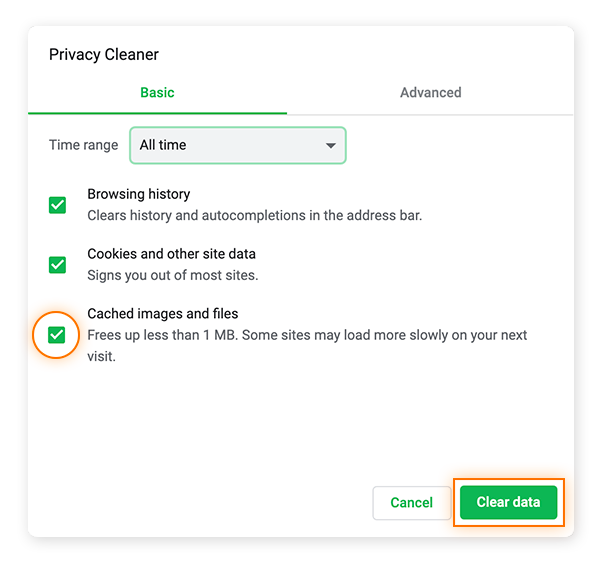
You can also use the keyboard shortcut Command + Shift + Delete to bring up the Privacy Cleaner window.
How to clean your system cache on Mac
Before you dive into clearing your system or user cache, it's a good idea to make sure you have an updated backup of all your files. When you go digging deep into system files, you could break something if you're not careful. As mentioned, some system and application cached files actually help your computer run normally, and they don't need to be purged. But here's how to access the system cache files on Mac in case you want to delete any of them:
-
Open Finder. From the Go menu, select Go to Folder...
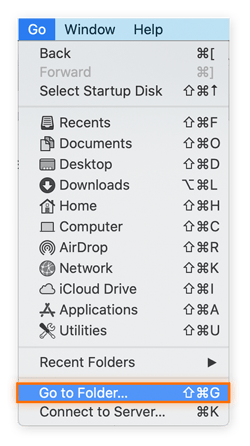
-
A box will pop up. Type in ~/Library/Caches/ and then click Go.
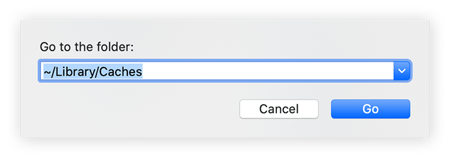
-
Your system, or library, caches will appear. You can now choose what to delete.

-
Here you can open up each folder and delete unneeded cache files by dragging them to the Trash and then emptying it. If you're not sure if you need them or not, you can try to search the name of the folder or files. It's best to err on the side of caution.
To be completely sure you're getting rid of only those files you don't need — and that you're rooting out all unnecessary data that's eating up your memory — consider a dedicated computer maintenance tool that will take care of everything for you, like Avast Cleanup for Mac.
How to clear the application cache on Mac
As with the system cache, you don't necessarily need to delete your Mac application cache. Some of the files stored there help your apps load faster. But you may need to delete others to troubleshoot problematic programs. If you're not an expert, consider doing further research or use a computer maintenance program to help you out. Regardless, here are the steps to manually clear the application cache on Mac:
-
Open Finder, select the Go menu, and then click Go to Folder…
-
Type in /Users/[YourUserName]/Library/Caches.

-
Then, you'll see the user caches for all your apps.

-
You can go into each folder, select the files inside, and drag them to the Trash. Make sure to empty the Trash to actually get rid of the files.
Cache clearing made simple with Avast Cleanup for Mac
While clearing your cache seems simple, it's not always as easy as you might think. You can clear your browser cache in just a few seconds, but it'll start to build up again immediately. And when it comes to system and application caches, unless you're an advanced user it's best not to mess around with system folders that might accidentally break something.
A dedicated computer maintenance solution like Avast Cleanup for Mac can help you by deleting your browser cache automatically and taking care of unnecessary files without deleting anything important.
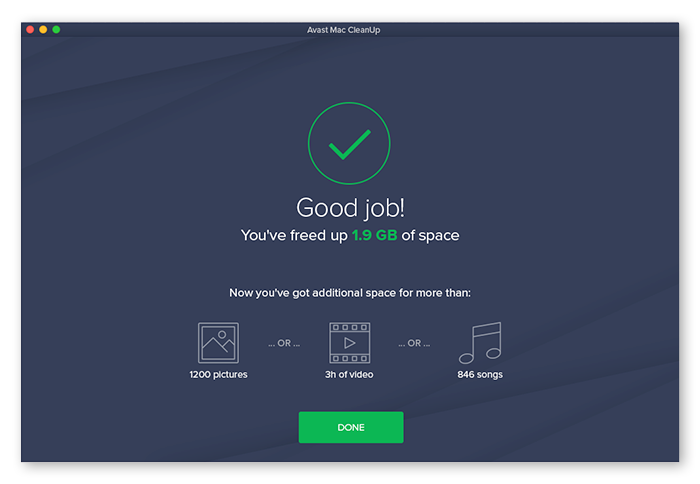
Want a few gigabytes of extra space instantly? Avast Cleanup will get rid of all the unnecessary data on your system while making sure you've saved the files you actually care about.
In addition to caches, crash reports, log files, old downloads, Avast Cleanup also frees up tons of space by helping you pare down your photo collection. You can find all your duplicate or very similar photos and save only your favorites, while getting rid of blurry or low-quality shots. You can also easily delete other large files you've accidentally saved twice, movies and TV shows you've already watched, and other unnecessary files. Plus, enjoy automatic maintenance to keep your Mac running lean and clean.
How To Clear Cache On Macbook Pro Retina
Source: https://www.avast.com/c-how-to-clear-cache-on-mac
Posted by: hughtitheivelt.blogspot.com

0 Response to "How To Clear Cache On Macbook Pro Retina"
Post a Comment